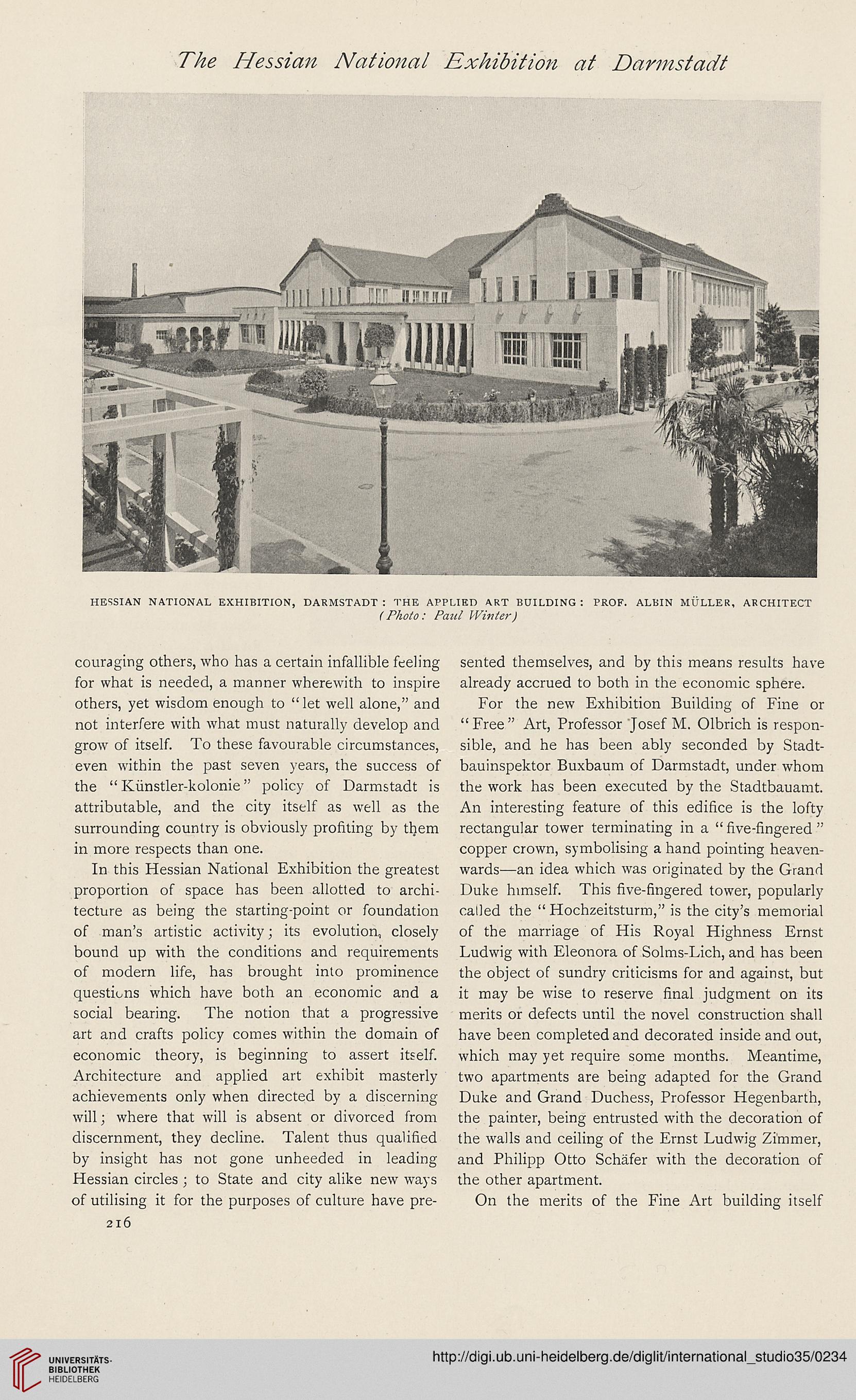The Hessian National Exhibition at Darmstadt
HESSIAN NATIONAL EXHIBITION, DARMSTADT : THE APPLIED ART BUILDING : PROF. ALBIN MULLER, ARCHITECT
( Photo: Paul Winter)
couraging others, who has a certain infallible feeling
for what is needed, a manner wherewith to inspire
others, yet wisdom enough to “let well alone,” and
not interfere with what must naturally develop and
grow of itself. To these favourable circumstances,
even within the past seven years, the success of
the “ Kiinstler-kolonie ” policy of Darmstadt is
attributable, and the city itself as well as the
surrounding country is obviously profiting by them
in more respects than one.
In this Hessian National Exhibition the greatest
proportion of space has been allotted to archi-
tecture as being the starting-point or foundation
of man’s artistic activity; its evolution, closely
bound up with the conditions and requirements
of modern life, has brought into prominence
questions which have both an economic and a
social bearing. The notion that a progressive
art and crafts policy comes within the domain of
economic theory, is beginning to assert itself.
Architecture and applied art exhibit masterly
achievements only when directed by a discerning
will; where that will is absent or divorced from
discernment, they decline. Talent thus qualified
by insight has not gone unheeded in leading
Hessian circles ; to State and city alike new ways
of utilising it for the purposes of culture have pre-
216
sented themselves, and by this means results have
already accrued to both in the economic sphere.
For the new Exhibition Building of Fine or
“Free” Art, Professor Josef M. Olbrich is respon-
sible, and he has been ably seconded by Stadt-
bauinspektor Buxbaum of Darmstadt, under whom
the work has been executed by the Stadtbauamt.
An interesting feature of this edifice is the lofty
rectangular tower terminating in a “ five-fingered ”
copper crown, symbolising a hand pointing heaven-
wards—an idea which was originated by the Grand
Duke himself. This five-fingered tower, popularly
called the “ Hochzeitsturm,” is the city’s memorial
of the marriage of His Royal Highness Ernst
Ludwig with Eleonora of Solms-Lich, and has been
the object of sundry criticisms for and against, but
it may be wise to reserve final judgment on its
merits or defects until the novel construction shall
have been completed and decorated inside and out,
which may yet require some months. Meantime,
two apartments are being adapted for the Grand
Duke and Grand Duchess, Professor Hegenbarth,
the painter, being entrusted with the decoration of
the walls and ceiling of the Ernst Ludwig Zi'mmer,
and Philipp Otto Schafer with the decoration of
the other apartment.
On the merits of the Fine Art building itself
HESSIAN NATIONAL EXHIBITION, DARMSTADT : THE APPLIED ART BUILDING : PROF. ALBIN MULLER, ARCHITECT
( Photo: Paul Winter)
couraging others, who has a certain infallible feeling
for what is needed, a manner wherewith to inspire
others, yet wisdom enough to “let well alone,” and
not interfere with what must naturally develop and
grow of itself. To these favourable circumstances,
even within the past seven years, the success of
the “ Kiinstler-kolonie ” policy of Darmstadt is
attributable, and the city itself as well as the
surrounding country is obviously profiting by them
in more respects than one.
In this Hessian National Exhibition the greatest
proportion of space has been allotted to archi-
tecture as being the starting-point or foundation
of man’s artistic activity; its evolution, closely
bound up with the conditions and requirements
of modern life, has brought into prominence
questions which have both an economic and a
social bearing. The notion that a progressive
art and crafts policy comes within the domain of
economic theory, is beginning to assert itself.
Architecture and applied art exhibit masterly
achievements only when directed by a discerning
will; where that will is absent or divorced from
discernment, they decline. Talent thus qualified
by insight has not gone unheeded in leading
Hessian circles ; to State and city alike new ways
of utilising it for the purposes of culture have pre-
216
sented themselves, and by this means results have
already accrued to both in the economic sphere.
For the new Exhibition Building of Fine or
“Free” Art, Professor Josef M. Olbrich is respon-
sible, and he has been ably seconded by Stadt-
bauinspektor Buxbaum of Darmstadt, under whom
the work has been executed by the Stadtbauamt.
An interesting feature of this edifice is the lofty
rectangular tower terminating in a “ five-fingered ”
copper crown, symbolising a hand pointing heaven-
wards—an idea which was originated by the Grand
Duke himself. This five-fingered tower, popularly
called the “ Hochzeitsturm,” is the city’s memorial
of the marriage of His Royal Highness Ernst
Ludwig with Eleonora of Solms-Lich, and has been
the object of sundry criticisms for and against, but
it may be wise to reserve final judgment on its
merits or defects until the novel construction shall
have been completed and decorated inside and out,
which may yet require some months. Meantime,
two apartments are being adapted for the Grand
Duke and Grand Duchess, Professor Hegenbarth,
the painter, being entrusted with the decoration of
the walls and ceiling of the Ernst Ludwig Zi'mmer,
and Philipp Otto Schafer with the decoration of
the other apartment.
On the merits of the Fine Art building itself




